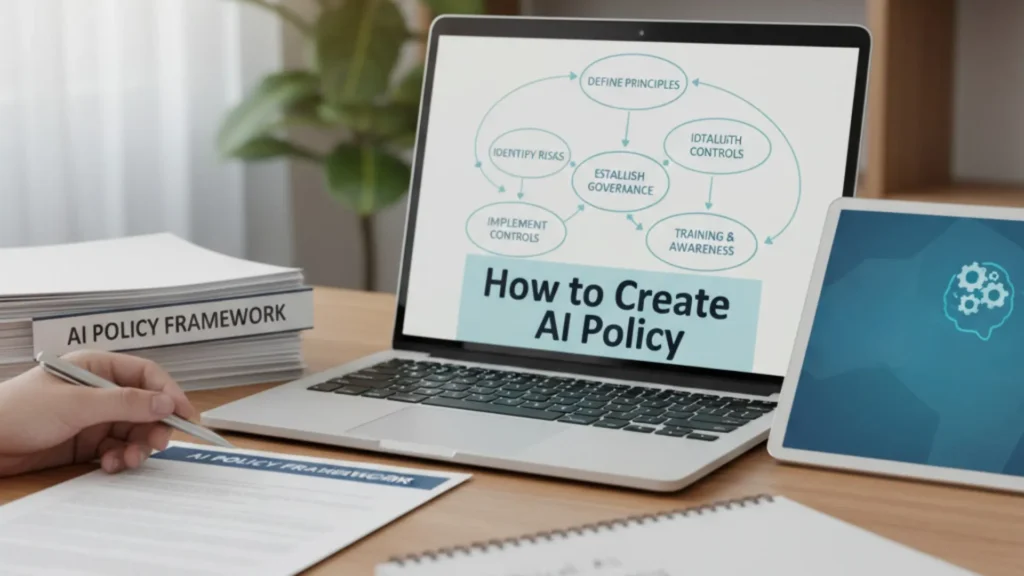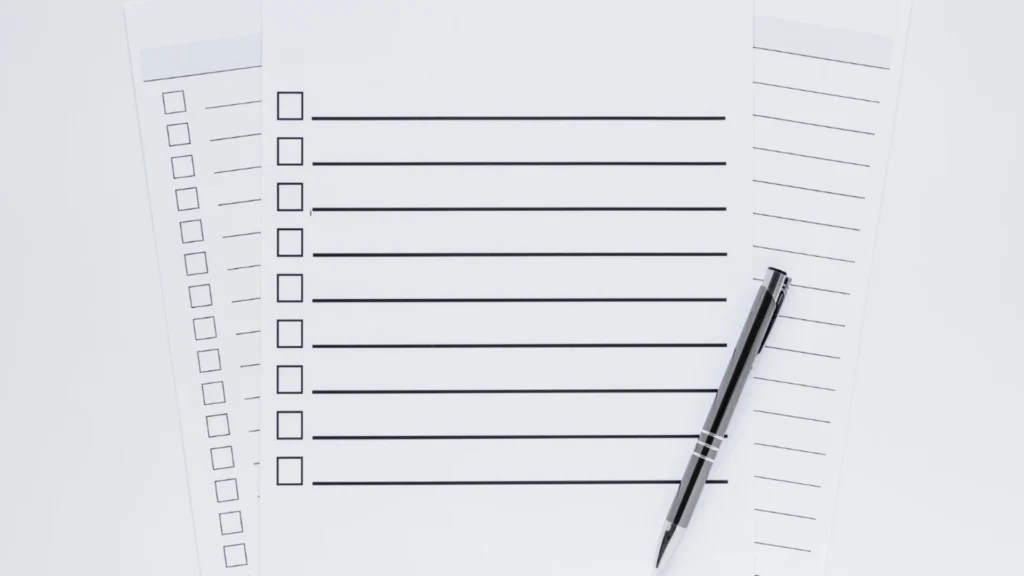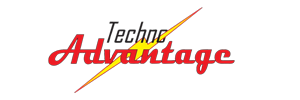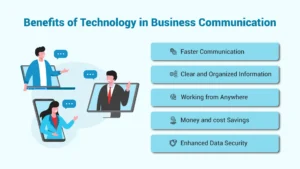An AI policy for companies is a written guide that tells your organization how AI tools should be used, managed, and controlled. Think of it as guardrails: not stifling innovation, but avoiding crashes.
- You’ll get a full roadmap: steps, sample clauses, and policy modules.
- You’ll see how to tie that roadmap into laws and frameworks so you’re not flying blind.
This guide is for SMEs, HR teams, legal, IT/security, and product leads, people responsible for making sure AI doesn’t become a liability.
Key Summary of this Article
- An AI policy defines how a company should use, manage, and govern AI tools responsibly — setting guardrails without blocking innovation.
- The policy is built from modular sections such as acceptable use, data privacy, governance, procurement, human oversight, and training.
- It helps companies reduce risks, meet legal and compliance obligations (EU AI Act, NIST AI RMF), and build trust and accountability.
- Creating an AI policy involves six practical steps — setting scope, forming a cross-functional team, mapping risks, drafting clauses, piloting, and reviewing regularly.
- Effective policies align with frameworks like NIST AI RMF and prepare companies for EU and U.S. AI regulations.
- Implementation includes a clear roadmap and measurable KPIs (e.g., training rates, audit results, compliance metrics).
- Supporting tools like templates, checklists, and training materials help teams apply, monitor, and continuously improve AI governance.

What is an AI Policy for Companies?
An AI policy for companies is a set of rules, principles, and responsibilities about how AI systems are adopted and used. It sits on top of an AI risk assessment and the ethics your business wants to uphold (i.e. AI ethics in business).
Types / Modules of Policy
You don’t get one single “AI policy”, you often break it into modules. Here are the main ones:
- Acceptable Use / Prohibited Use — what employees can and cannot do with AI
Example: “You may use AI for drafting social media posts; you may not use it to generate final legal contracts.” - Governance & Oversight — who owns decisions, how escalation works
Example: All new AI initiatives must go through the AI Steering Committee. - Procurement / Vendor Use — how to pick, vet, and contract third‑party AI tools
Example: Require vendors to share details about their training data, bias testing, and security. - Data Handling & Privacy — rules for data collection, storage, access, anonymization
Example: All customer data used for AI must be pseudonymized and stored under encryption.
Types / Modules of Policy
Term | What It Covers | Example |
Policy | The high‑level “do’s and don’ts” | “Employees must not input proprietary data into public AI tools.” |
Procedure | Step‑by‑step instructions | “How to submit vendor for an AI tool evaluation.” |
Standard | Quantitative or technical rules | “Models must pass bias audit with < 5% error rate.” |
Policies are the “what,” procedures are “how,” and standards are “how well.”

Why Your Company Needs an AI Policy
I could list risks all day, but here are the most compelling reasons, with examples.
Risk Mitigation & Preventing Harm
AI tools can seep into unexpected places. Without rules, you risk data leaks, unfair bias, or embarrassing outputs. A well‑defined AI acceptable use policy helps you catch problems before they blow up. But here’s another question – can AI really replace cybersecurity?
Example: A marketing team used a public generative AI model on internal customer lists, inadvertently exposing private information. If an AI policy had prohibited that, the slip might have been prevented.
Legal & Compliance Pressure
Regulators in the EU, U.S. states, and elsewhere are moving fast. If you lack a proper policy, you’re more vulnerable to fines or enforcement. That’s part of managing AI compliance risks.
Example: In the EU, the AI Act will classify some tools as “high-risk”, meaning extra oversight, documentation, human oversight, audits, etc.
Building Trust & Reputation
If employees or clients fear hidden AI use or unfairness, trust erodes. A clear policy shows you take it seriously.
Example: A financial services firm rolled out an AI assistant but included a transparent statement that human sign-off is required, helping reassure customers.
Because Most Don’t Have One
Surprisingly, many organizations using AI still lack formal policies. When things go wrong, they scramble. That’s one reason having even a basic AI policy for companies is better than nothing. With policies in place, you can get proactive IT support for your business.
Key Components of an Effective AI Policy
Below is a fleshed‑out checklist of sections your policy should include. I’ll add examples and tips. These components also help with EU AI Act compliance, AI governance standards, and broader corporate AI governance.
1. Acceptable Use & Prohibited Uses
- Clear definitions: what is allowed, what is off-limits
- Example: “Allowed: using AI to draft ideas, content, or internal analyses. Prohibited: using AI to generate misleading or harmful content, impersonate individuals, or leak private data.”
2. Data Privacy & Security
- Rules on data inputs, storage, access, retention, encryption
- Example: “Input data must be anonymized; logs must be retained for X months; access to logs is on a need-to-know basis.”
3. Ethical Guidelines & Bias Mitigation
- Fairness, non-discrimination, explainability
- Example: “AI systems used in hiring must be bias-tested, with performance monitored across demographic slices.”
4. Approved Tools & Procurement Process
- Vetting criteria, risk checks, contract clauses
- Example: “Before procurement, the vendor must submit their model training description, security certificate, audit rights, and mitigation plans.”
5. Human Oversight & Decision Accountability
- Clear boundaries for when humans must intervene
- Example: “AI may propose actions, but final approval lies with a human, especially for decisions affecting someone’s rights or finances.”
6. Training & Awareness
- Required training, refreshers, awareness campaigns
- Example: “All employees must complete a one-hour AI safety and policy course annually.”
7. Monitoring, Logging & Incident Response
- Detection of misuse, logging, correction procedures
- Example: “If an AI model produces a false, biased, or offensive result, employees must log it, freeze the tool for review, and escalate.”
8. Policy Governance & Version Control
- Who maintains the policy, review schedule, versioning
- Example: “The policy is reviewed every six months by the AI Committee; changes recorded in version logs.”
9. Link to NIST AI RMF
- Ensure your policy maps to the four core functions: Govern, Map, Measure, Manage (i.e. tie your rules to that structure).
The NIST AI RMF is a voluntary framework that helps organizations manage AI-related risk across the whole lifecycle. It’s not rigid, but it offers useful structure.
- Govern: roles, oversight, alignment
- Map: identify and classify AI systems, risks
- Measure: audit, metrics, performance checks
- Manage: respond to incidents, update, adapt
(The NIST AI RMF is available as a public reference you can adapt for your organization.)
Bonus: many organizations are now using the Responsible AI Institute’s AI Policy Template as a starting point, built with influences from NIST and ISO standards.

How to Create an AI Policy: 6 Practical Steps
More detail this time, plus example tips so it doesn’t stay abstract.
Step 1. Set Scope & Objectives
Decide: Which teams and tools are in scope? What are the biggest risks? What do you hope to achieve (trust, compliance, safety)?
Tip: Start with high-impact areas like HR, marketing, customer service.
Step 2. Form a Cross‑Functional Team
AI touches many parts of an org. Include legal, IT/security, HR, product, and operations.
Tip: Have regular workshops for each group to surface use cases and risks.
Step 3. Conduct a Risk Inventory & Mapping
List all AI tools currently in use or under consideration. For each, note data sources, risk levels, dependencies, impact.
Example: You discover that your customer support team uses a public AI chatbot tool without oversight. That becomes a flagged risk to manage.
You can create a spreadsheet with columns:
- Tool name
- Use case / department
- Data types used
- Risk level (low / medium / high)
- Controls in place
- Next review date
Step 4. Draft Policy + Sample Clauses
Use the components above. For each section, include sample language. Use plain, concrete wording.
Example clause:
“No employee may input personally identifiable customer data into an external AI tool unless the data is anonymized and encrypted. Violations may lead to loss of tool access or disciplinary measures.”
Step 5. Pilot, Train & Monitor
Test the policy in one department or project. Train the people involved. Track violations or confusion, gather feedback, adjust.
Example: You pilot the policy in marketing, you realize the acceptable use section was vague about “public tools,” so you clarify.
Step 6. Review & Update Schedule
Set a review cadence (e.g. every 6 months). Record all changes. Use version control.
Tip: Always tie updates to new threats, incidents, or law changes.
Compliance & Regulatory Mapping
Bringing your policy into real legal context, this is where it earns its weight.
Mapping to NIST AI RMF
Use your policy to operationalize those four functions:
- Govern: policy, roles, oversight
- Map: classify AI systems, risk profiles
- Measure: audits, performance checks, metrics
- Manage: incident response, updates, mitigation
Using NIST as a backbone gives your internal policy credibility and makes it easier to review against external standards.
EU AI Act & High-Risk Systems
Under the EU AI Act, certain AI systems are labeled “high-risk”. If your tools fall into those categories, extra obligations kick in (audit, human oversight, documentation, etc.).
Examples of high-risk AI systems per the Act’s Annex III include AI used in:
- Biometric identification
- Infrastructure (transport, energy)
- Education, employment, worker management
- Healthcare diagnosis or treatment
- Credit scoring or financial decisions
- Border control and justice systems
- Public services (e.g., benefits eligibility)
If your AI tool is using profiling (making decisions about individuals’ health, finances, employment), it’s likely high-risk. That means you must do risk mitigation, keep logs, ensure transparency, and possibly submit to conformity assessment.
U.S. & State-Level Trends
- Some U.S. states are drafting AI laws focused on transparency, worker rights, or algorithmic accountability.
- Federal AI policy is still in flux, keep an eye on proposed bills, especially around federal procurement, rights to explanation, liability.
- In California, AI models used in consumer settings may need disclosures or bias audits.
What to Watch
- EU: implementation deadlines, clarifying guidelines
- U.S.: federal AI law drafts, consumer protection overlap
- States: algorithmic fairness laws, transparency ordinances
If your policy is flexible, you’ll be better positioned to adapt to local or global changes.
Implementation Roadmap & KPIs
Let me lay out an extended roadmap and stretch your thinking about key metrics.
Timeline & Milestones : 0–3 months
- Assemble the cross‑functional team
- Audit and list all AI tools in use
- Draft initial version of policy
- Pilot in one team (e.g. marketing or HR)
- Run awareness sessions
3–6 months
- Formal rollout company-wide
- Mandatory training for employees
- Begin logging usage and monitor compliance
- Start vendor reviews / assessments
- First round of internal checks
6–12 months
- Conduct fuller audits
- Collect feedback, refine policy
- Enforce sanctions for violations (where necessary)
- Version 2.0 of the policy
- Assess alignment with emerging regulation
Beyond 12 months
- Continue policy refresh cycles
- Keep mapping new AI initiatives into the policy
- Stay informed of regulatory change, court cases
- Benchmark against peer organizations
Suggested KPIs & Metrics
Here’s a more robust list of metrics you can track:
- % of employees trained (vs total)
- # AI tools approved / used (and # rejected)
- # audits performed
- # policy violations / incidents logged
- Mean time to detect anomaly / incident
- Mean time to remediate / respond
- % of vendors audited / compliant
- % of AI models passing bias / fairness tests
- Number of policy updates / revisions per year
- User satisfaction / trust scores (via surveys)
You want some operational and some qualitative metrics so you see both numbers and perceptions.

Templates, Checklists & Downloads
Here’s what you should package for your teams to use directly:
- AI Policy Template (Word) — with blank slots and sample clauses
- AI Audit Checklist (Excel) — checklist mapped to risk domains (data, bias, security, transparency)
- Training Slides (PPT) — short deck to introduce policy, risks, best practices
- AI Use Inventory Spreadsheet — to track all tools, classification, and review dates
Optional extras:
- Vendor risk questionnaire
- Incident report form
- Glossary of AI / bias / metrics terms
Many organizations also adapt open templates such as the AI Policy Template from governance libraries, or from the Responsible AI Institute as a starting point and customize to their context.
Frequently Asked Questions
Q: Is a small startup too small for this?
Q: How should employees learn the policy?
Q: What triggers a policy update?
Q: What should the consequences be for violations?
Q: How do we check whether an AI is “high-risk”?
Conclusion
We’ve now walked through a more detailed version of how to build an AI policy for companies, from theory to sections to rollout to compliance mapping. The longer version gives you room to adapt it to your reality.
Having a policy isn’t just for show. It becomes your internal compass when tricky decisions arise, and your defense when regulators or customers probe. Start with what you can manage today. As your AI footprint grows, your policy will grow too.
Even if your first version isn’t perfect, it’s better than nothing. The key is to begin, you’ll refine from there. If you like, I can format this into a ready‑to‑publish article, or hand you a beautifully laid out Word + Excel + PPT bundle. Want me to package that for you now?
Author
-

Jay S. Allen, MCP, MCSA, MCSE, MCSE+ Security, is an experienced IT professional with more than 20 years in the industry. He specializes in delivering enterprise-level cybersecurity and IT support solutions tailored to small and mid-sized businesses. Through Techno Advantage, Jay is dedicated to helping organizations strengthen their security posture and achieve greater efficiency through smart, scalable technology solutions.










